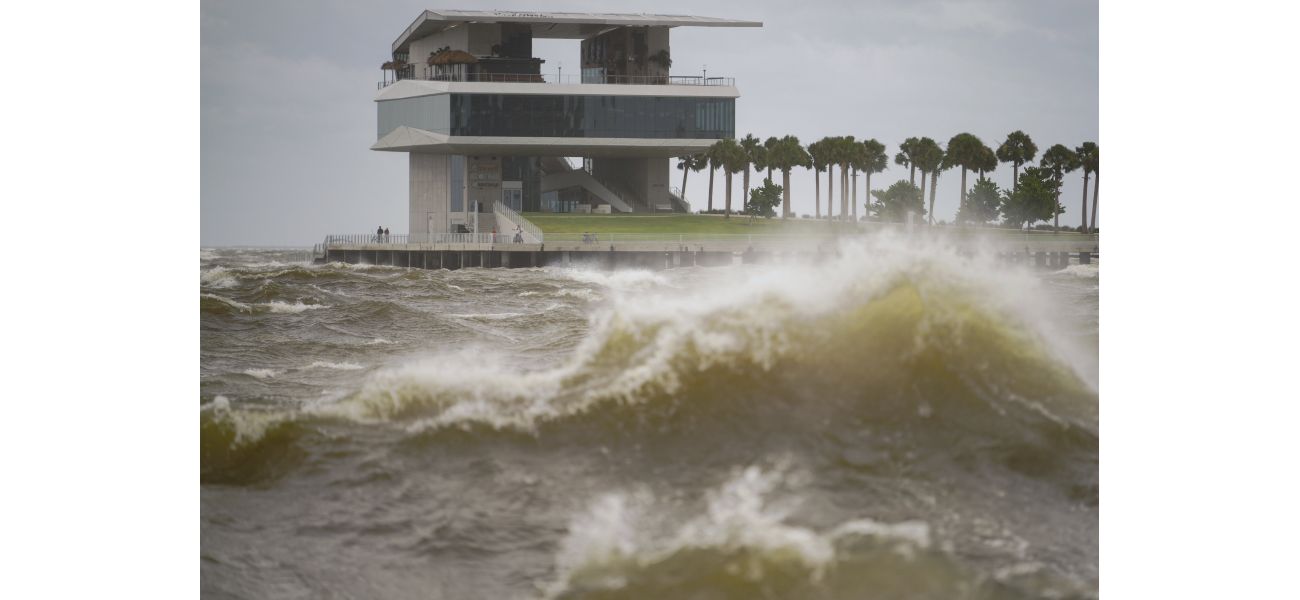Hurricane Helene hits northwestern Florida as a Category 4 storm.
Strong winds cause power outages in multiple states, leading to declared emergencies and affecting over 250,000 properties.
September 27th 2024.

Hurricane Helene, a powerful Category 4 storm, made landfall in Florida's northwestern coast on Thursday evening, bringing with it a plethora of dangerous weather conditions. The storm was moving quickly and had the potential to cause catastrophic storm surges, strong winds, heavy rains, and flash floods across a large portion of the southeastern United States.
In the hours leading up to the landfall, authorities in Georgia reported two fatalities from a possible tornado, and Florida Governor Ron DeSantis confirmed that one person had died while driving on Interstate 4 when a sign fell on their car. The storm also caused power outages for over 1 million homes and businesses in Florida and over 50,000 in Georgia, according to the tracking site poweroutage.us.
States of emergency were declared in Florida, Georgia, the Carolinas, Virginia, and Alabama as the storm approached. In the Pacific, former Hurricane John was downgraded to a tropical storm as it moved along the coast of Mexico, threatening areas with flash flooding and mudslides. Meanwhile, Tropical Storm Isaac was expected to strengthen as it moved east away from the United States and could potentially become a hurricane by the end of the week.
Governor DeSantis urged residents to stay safe and take precautions as the storm passed through, warning of the potential for more fatalities and significant property damage. He also announced that 3,500 National Guardsmen were prepared to respond to any emergencies.
Hurricane Helene made landfall in northwestern Florida as a Category 4 storm, with maximum sustained winds of 140 mph. The National Hurricane Centre in Miami warned of potentially catastrophic flooding along the Gulf Coast, particularly in Florida's Apalachee Bay area. The storm also brought hurricane warnings and flash flood warnings to areas as far inland as northern Georgia and western North Carolina.
As of 11 p.m. EDT, over 885,000 customers in Florida were without power, according to poweroutage.us. The majority of these outages were in the Big Bend area, where Helene made landfall.
Meanwhile, former Hurricane John was downgraded to a tropical storm as it moved slowly along Mexico's coast, causing severe flash flooding. It had initially made landfall as a Category 3 hurricane in Acapulco before weakening inland and reemerging over the ocean. The storm then strengthened back into a hurricane before eventually being downgraded again. The National Hurricane Centre expected it to continue weakening in the following days.
The Gulf Coast of Florida was bracing for the impact of Hurricane Helene on Thursday evening. The storm, classified as a Category 4, was moving at an alarming speed and threatened to cause severe damage with its strong winds, heavy rains, and potential storm surge. The Big Bend area of Florida's northwestern coast was the first to feel the effects of the hurricane, as it made landfall with great force.
The forecasters had issued a warning about the possibility of a "catastrophic" storm surge, which could potentially cause widespread flooding and destruction. But the threat didn't just end at the coast; the southeastern US was also at risk of flash floods and damaging winds, even hundreds of miles inland. The situation was dire, and everyone was advised to take precautions and stay safe.
As Hurricane Helene approached, it left a trail of destruction in its wake. In south Georgia, there were reports of two people killed in a potential tornado. And in a tragic incident, Florida Governor Ron DeSantis revealed that one person had died while driving on Interstate 4 when a sign fell onto their car. The storm had also caused power outages, leaving over 1 million homes and businesses in Florida and over 50,000 in Georgia without electricity, according to poweroutage.us.
The severity of the situation had prompted authorities to declare states of emergency in several states, including Florida, Georgia, the Carolinas, Virginia, and Alabama. The potential danger was not limited to Hurricane Helene; in the Pacific, former Hurricane John had strengthened into a hurricane again, causing concern for areas along Mexico's western coast. The storm was expected to bring flash flooding and mudslides to the region, and it had already caused significant damage and disruption earlier in the week.
Meanwhile, in the Atlantic Ocean, Tropical Storm Isaac had formed and was slowly moving away from the US. However, forecasters warned that it could strengthen into a hurricane by the end of the week, posing a potential threat to the east coast. The situation was being closely monitored, and everyone was advised to stay updated and prepared.
As the night progressed, Florida Governor Ron DeSantis gave a press conference, providing updates on the situation. He confirmed the heartbreaking news of one person's death due to the storm and urged everyone to take the necessary precautions. He also warned that there could be more fatalities as the storm continues to advance. The Governor announced that 3,500 National Guardsmen were ready to assist in the response efforts, and he asked for everyone's thoughts and prayers for those affected.
Hurricane Helene finally made landfall in northwestern Florida, near the town of Perry, late on Thursday. The National Hurricane Center in Miami reported that the storm had maximum sustained winds of 140 mph. The forecasters had warned of "catastrophic" flooding in Florida's Apalachee Bay, and the storm surge could reach up to 20 feet. The hurricane warnings and flash flood warnings were in effect for areas beyond the coast, including northern Georgia and western North Carolina.
The power outages in Florida continued to rise, with over 885,000 customers without electricity as of 11 p.m. EDT, according to poweroutage.us. The map showed that most customers in the Big Bend area, where Helene had made landfall, were affected by the power outages.
In the Pacific, former Hurricane John had weakened and was downgraded to a tropical storm. However, it was still moving slowly along the coast of the Mexican state of Michoacan, causing concern for potential flash flooding. The US National Hurricane Center reported that the storm had sustained wind speeds of 70 mph. John had initially made landfall in Acapulco as a Category 3 hurricane, causing significant damage and destruction. After weakening inland, it reemerged over the ocean and strengthened into a hurricane again on Thursday.
The hurricane center predicted that the storm would weaken further on Thursday night and into Friday. However, the threat of flash flooding and mudslides was still present, and everyone in the affected areas was advised to stay vigilant and take necessary precautions. The hurricane season had caused widespread damage and destruction, and the safety of everyone was of utmost importance.
In the hours leading up to the landfall, authorities in Georgia reported two fatalities from a possible tornado, and Florida Governor Ron DeSantis confirmed that one person had died while driving on Interstate 4 when a sign fell on their car. The storm also caused power outages for over 1 million homes and businesses in Florida and over 50,000 in Georgia, according to the tracking site poweroutage.us.
States of emergency were declared in Florida, Georgia, the Carolinas, Virginia, and Alabama as the storm approached. In the Pacific, former Hurricane John was downgraded to a tropical storm as it moved along the coast of Mexico, threatening areas with flash flooding and mudslides. Meanwhile, Tropical Storm Isaac was expected to strengthen as it moved east away from the United States and could potentially become a hurricane by the end of the week.
Governor DeSantis urged residents to stay safe and take precautions as the storm passed through, warning of the potential for more fatalities and significant property damage. He also announced that 3,500 National Guardsmen were prepared to respond to any emergencies.
Hurricane Helene made landfall in northwestern Florida as a Category 4 storm, with maximum sustained winds of 140 mph. The National Hurricane Centre in Miami warned of potentially catastrophic flooding along the Gulf Coast, particularly in Florida's Apalachee Bay area. The storm also brought hurricane warnings and flash flood warnings to areas as far inland as northern Georgia and western North Carolina.
As of 11 p.m. EDT, over 885,000 customers in Florida were without power, according to poweroutage.us. The majority of these outages were in the Big Bend area, where Helene made landfall.
Meanwhile, former Hurricane John was downgraded to a tropical storm as it moved slowly along Mexico's coast, causing severe flash flooding. It had initially made landfall as a Category 3 hurricane in Acapulco before weakening inland and reemerging over the ocean. The storm then strengthened back into a hurricane before eventually being downgraded again. The National Hurricane Centre expected it to continue weakening in the following days.
The Gulf Coast of Florida was bracing for the impact of Hurricane Helene on Thursday evening. The storm, classified as a Category 4, was moving at an alarming speed and threatened to cause severe damage with its strong winds, heavy rains, and potential storm surge. The Big Bend area of Florida's northwestern coast was the first to feel the effects of the hurricane, as it made landfall with great force.
The forecasters had issued a warning about the possibility of a "catastrophic" storm surge, which could potentially cause widespread flooding and destruction. But the threat didn't just end at the coast; the southeastern US was also at risk of flash floods and damaging winds, even hundreds of miles inland. The situation was dire, and everyone was advised to take precautions and stay safe.
As Hurricane Helene approached, it left a trail of destruction in its wake. In south Georgia, there were reports of two people killed in a potential tornado. And in a tragic incident, Florida Governor Ron DeSantis revealed that one person had died while driving on Interstate 4 when a sign fell onto their car. The storm had also caused power outages, leaving over 1 million homes and businesses in Florida and over 50,000 in Georgia without electricity, according to poweroutage.us.
The severity of the situation had prompted authorities to declare states of emergency in several states, including Florida, Georgia, the Carolinas, Virginia, and Alabama. The potential danger was not limited to Hurricane Helene; in the Pacific, former Hurricane John had strengthened into a hurricane again, causing concern for areas along Mexico's western coast. The storm was expected to bring flash flooding and mudslides to the region, and it had already caused significant damage and disruption earlier in the week.
Meanwhile, in the Atlantic Ocean, Tropical Storm Isaac had formed and was slowly moving away from the US. However, forecasters warned that it could strengthen into a hurricane by the end of the week, posing a potential threat to the east coast. The situation was being closely monitored, and everyone was advised to stay updated and prepared.
As the night progressed, Florida Governor Ron DeSantis gave a press conference, providing updates on the situation. He confirmed the heartbreaking news of one person's death due to the storm and urged everyone to take the necessary precautions. He also warned that there could be more fatalities as the storm continues to advance. The Governor announced that 3,500 National Guardsmen were ready to assist in the response efforts, and he asked for everyone's thoughts and prayers for those affected.
Hurricane Helene finally made landfall in northwestern Florida, near the town of Perry, late on Thursday. The National Hurricane Center in Miami reported that the storm had maximum sustained winds of 140 mph. The forecasters had warned of "catastrophic" flooding in Florida's Apalachee Bay, and the storm surge could reach up to 20 feet. The hurricane warnings and flash flood warnings were in effect for areas beyond the coast, including northern Georgia and western North Carolina.
The power outages in Florida continued to rise, with over 885,000 customers without electricity as of 11 p.m. EDT, according to poweroutage.us. The map showed that most customers in the Big Bend area, where Helene had made landfall, were affected by the power outages.
In the Pacific, former Hurricane John had weakened and was downgraded to a tropical storm. However, it was still moving slowly along the coast of the Mexican state of Michoacan, causing concern for potential flash flooding. The US National Hurricane Center reported that the storm had sustained wind speeds of 70 mph. John had initially made landfall in Acapulco as a Category 3 hurricane, causing significant damage and destruction. After weakening inland, it reemerged over the ocean and strengthened into a hurricane again on Thursday.
The hurricane center predicted that the storm would weaken further on Thursday night and into Friday. However, the threat of flash flooding and mudslides was still present, and everyone in the affected areas was advised to stay vigilant and take necessary precautions. The hurricane season had caused widespread damage and destruction, and the safety of everyone was of utmost importance.
[This article has been trending online recently and has been generated with AI. Your feed is customized.]
[Generative AI is experimental.]
0
0
Submit Comment





